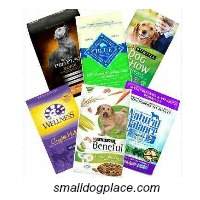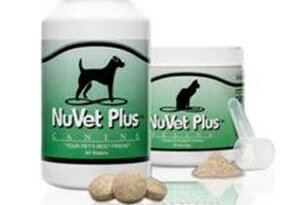A Dog Food Label Deciphered
 How to Read Dog Food Labels
How to Read Dog Food LabelsIf you know how to read dog food labels, you are one step farther towards providing the best commercial diet for your small breed dog.
I am one of those people who
pour over human food labels hoping to decipher just what it is that I’m eating
so naturally I also want to know what my dogs are eating too.
Sounds easy, doesn’t it? Sadly, I found that the job of finding the
perfect food might take me a life time of full time effort which I surely do
not have.
Still, I knew that my dogs
would be happier and healthier if I could provide a high quality diet that was
easy to serve and also affordable, so I began looking into what dog food
manufacturers place on their labels.
In
this article I will be looking at commercial kibble or the dry food we purchase
for our dogs.
Before we get started, you should know that AAFCO stands for Association of American Feed Control Officials. This organization sets the nutritional standards for pet foods sold in the United States.
There are at least eight areas of the dog food label you should examine when making a choice.
Guaranteed Analysis
This is where you will find the minimum amounts of protein
and fat and the maximum amounts of moisture and fiber.
But this is where it gets tricky, especially
if you want to compare one type of food to another such as a kibble and a canned food.
The protein and fat levels are listed on the label in an “as-is” basis
which includes water.
Each dog food can
have a different level of moisture which would affect how much of the nutrient
is in the food on a dry-weight basis.
The comparison of these two dog food labels requires a little math:
- Locate the % of the nutrient such as protein on
the label - Locate the % of moisture on the label
- Subtract the % of moisture from 100 to get the %
of dry - Divide the number from number 1 by the number in
3 and multiple by 100
Example: Bag of Dry
Kibble For Puppies
- Crude Protein 27%
- Crude Fat 16.0%
- Crud Fiber 4.0%
- Moisture 10%
In this example, I subtract 10% from 100 to get 90%
dry. I divide 27 by 90 and multiple by
100 to get 30% protein on a dry basis. The AAFCO or American Association of
Feed Control Officials sets the guidelines for the type and amount of nutrients
dogs need.
For adult dogs, foods should
contain no less than 18% protein and for puppies the food should have a minimum
of 22 percent protein. In the case
above, the amount of 30% is clearly higher than the minimum requirements.
The Nutritional Adequacy Statement (AAFCO Statement)
This statement shows the method of testing used to
determine the nutritional adequacy of a pet food. It shows that the food provides complete and balanced
nutrition for each specific life stage such as puppy, pregnant, adults, seniors,
etc. that it is intended for.
Alternately, the statement might say that it
is nutritionally adequate for all life stages.
If you cannot find this statement, chances are that the food is
not nutritionally complete. Here are a couple of examples to look for on the
label:
- This product is formulated to meet the
nutritional levels established by the AAFCO Dog Food Nutrient Profiles - Animal feeding tests using AAFCO procedures
substantiate that XXX provides complete and balanced nutrition.
Ingredient List
INGREDIENTS LIST
Deboned Lamb, Oatmeal, Whole Ground Brown Rice, Whole Ground Barley, Chicken Meal, Turkey Meal, Rice Bran, Tomato Pomace (source of Lycopene), Peas, Chicken Fat (preserved with Mixed Tocopherols), Natural Chicken Flavor, Sunflower Oil (source of Omega 6 Fatty Acids), Whole Potatoes, Flaxseed (source of Omega 3 and 6 Fatty Acids), Alfalfa Meal, Whole Carrots, Whole Sweet Potatoes, Blueberries, Cranberries, Apples, Blackberries, Pomegranate, Spinach, Pumpkin, Barley Grass, Dried Parsley, Garlic, Dried Kelp, Yucca Schidigera Extract, L-Carnitine, L-Lysine, Glucosamine Hydrochloride, Turmeric, Dried Chicory Root, Oil of Rosemary, Beta Carotene, Vitamin A Supplement, Thiamine Mononitrate (Vitamin B1), Riboflavin (Vitamin B2), Niacin (Vitamin B3), d-Calcium Pantothenate (Vitamin B5), Pyridoxine Hydrochloride (Vitamin B6), Biotin (Vitamin B7), Folic Acid (Vitamin B9), Vitamin B12 Supplement, Calcium Ascorbate (source of Vitamin C), Vitamin D3 Supplement, Vitamin E Supplement, Iron Amino Acid Chelate, Zinc Amino Acid Chelate, Manganese Amino Acid Chelate, Copper Amino Acid Chelate, Choline Chloride, Sodium Selenite, Calcium Iodate, Salt, Caramel, Calcium Carbonate, Potassium Chloride, Dried Yeast (source of Saccharomyces cerevisiae), Dried Lactobacillus acidophilus fermentation product, Dried Bacillus subtilis fermentation product, Dried Enterococcus faecium fermentation product.
As is the case with human food, dog food manufactures are
required to list the ingredients in descending order by amount on a dry weight
basis and must list every ingredient.
Again, this can be tricky and dog food
manufactures have ways to get around this requirement, thus making their foods
look better and more nutritious as stated on their dog food label.
For
example, if the main ingredient in a dog food was corn, the manufacturer could
list the corn as corn flour, corn germ meal, corn bran and corn middlings. If chicken is also part of the food, the
manufacturer can then list chicken or even chicken byproducts as the first
ingredient.
Better quality foods will
have at least two animal protein sources listed in the first few ingredients.
To make matters more confusing, food manufactures have their
own vocabulary. Here are a few commonly used terms on dog food labels:
Animal byproduct
meal: Any part of the rendered
animal and in this case, it could be any kind of animal, that does not fit into
another definition but it cannot contain hair, horns, hoofs, hide, manure or
intestinal content.
Byproducts: Refers to any non-human grade protein
obtained from the animal carcass. Use
your imagination. Actually by-products are not necessarily all bad. Before we
domesticated dogs they killed and ate the whole animal. But in a high-quality dog food, the main
protein source should be the real thing, not the stuff that gets thrown away
when food is processed for human consumption.
Meat: This is a little easier to understand. It is the clean flesh of the slaughtered mammals
such as cattle, swine, sheet or goat that comes from the muscle, tongue,
diaphragm, heart or esophagus
Meat Meal: This refers to the rendered meal made from
animal tissues. It cannot contain blood,
hair, hoofs, horns, hide trimmings, manure or intestinal content and cannot
contain more than 14% indigestible materials. Meat meal may not sound terribly
appetizing to humans but it can contain more minerals than meat.
Meat byproducts: This is the fresh, non-rendered clean parts
of the slaughtered animal. There is no
meat, but it does contain lungs, spleens, kidneys, brains, lovers, blood,
bones, fat, stomachs and intestines. It
cannot contain hair, horns, teeth, or hoofs.
Meat and Bone
Meal: This is similar to meat
meal, but can also contain bone.
Poultry or chicken
or turkey byproduct meal: This
is the ground, rendered clean parts of the carcass of poultry or if chicken is
used exclusively it is made entirely of chicken. It can include necks, feet, undeveloped eggs
and intestines. It cannot contain beaks
or feathers.
Poultry, chicken
or turkey byproducts: This
contains all non-rendered parts of the poultry, chicken or turkey but cannot
contain feces or foreign matter.
Product Names
Here are a few more definitions to help you understand the
dog food label. Some manufactures are using terms
such as premium, super premium, ultra-premium, holistic or even gourmet.
There are no guidelines for using these
labels and so consumers should know that these so called premium or gourmet
foods are no different or have any higher quality of ingredients than any other
brands of dog foods. This is simply a
marketing ploy.
If a food says it is organic on the dog food label, it must be certified as
organic by the USDA and produced and processed without chemical pesticides,
synthetic fertilizers, hormones and antibiotics.
If the food is stated as being natural, it is free of food coloring and
chemical additives.
There is also what the AAFCO calls the 95% rule. At least 95% of the product must be the named
ingredient, not counting water and “condiments.”
If the product name lists one
ingredient, such as chicken dog food, then 95% of the total weight of the food
must be chicken.
If there is a
combination such as chicken and brown rice formula the combination of
ingredients must equal 95% of the total weight.
Feeding Guidelines
These guidelines on the dog food label tell the dog owner how much to feed based
on their pet’s body weight. One
difference between a high quality and a low quality food is the digestibility
of the food.
This is the amount of the
ingredients in the food that the animal can break down and absorb. The dog can use a more highly digestible food
and so will need less of it to get the same nutritional value.
A diet of less digestible food requires that the
animal eat more of it per day to assure they are getting the same
nutrition.
Sometimes you will discover
that a higher priced food is actually cheaper in the long run because the dog
requires less of it. And, lest I say,
what goes in must come out, so higher priced food also tend to produce less
feces for later clean up.
Net Weight
The package should state the net weight and this requirement is strictly regulated by the U.S. Fair Packaging and Labeling Act. It tells you the weight of the product and is especially important towards helping you understand what you are paying for when comparing products.
Manufactures play plenty of tricks such
as adding air to the product to fill a bigger bag with less dog food, so be
sure to compare the net weight stated on the dog food label when comparing product pricing.
These weights can change over time, so it is
important to know how much food you are actually buying. There seems to be a
trend in recent years to purchase smaller and smaller bags of the foods.
Manufacturer’s Information
Pet food labels must include the manufacturer’s name and address and preferably a telephone number. Many nowadays also provide a website and even an email address.
Many products on the shelves are not actually made by the brand or company selling the product. The “manufactured by…” statement on the dog food label will let you know who is actually making the food and who you should be researching.
If you live in the United States of America, you should be purchasing food manufactured in the USA. Furthermore, the ingredients that go into your dog food should also be produced in the USA.
You may also want to avoid manufacturers involved in any recall, although this is not always possible.
Expiration Date
Finally, it is always a good idea to
look at the expiration date. Most dry
foods have expiration dates approximately one year after the food is
manufactured.
The date does not tell you
if the ingredients were stored improperly before being manufactured into a dog
food.
Even after manufactured, the
nutritional content may not be at its premium if stored in warm, humid
environment. The date does tell you when
it was manufactured and then you be the judge.
Does This Article Deserve Your Thumbs Up?
We always appreciate your support and encouragement. Your thumbs up means so much to us.

Free Monthly Newsletter
Sign Up for Our Free Newsletter and get our Free Gift to You.
my E-book, The Top 10 Mistakes People Make When Choosing a Dog (and how to avoid them)
If you enjoyed this page, I’d love it if you’d let me know. Just click the button below. Thank you.
Sharing is Caring





Hello my family member! I wish to say that this article is awesome, great written and come with approximately all vital infos. I would like to look extra posts like this .
Oprogramowanie do monitorowania telefonów komórkowych CellSpy jest bardzo bezpiecznym i kompletnym narzędziem, najlepszym wyborem do efektywnego monitorowania telefonów komórkowych. Aplikacja może monitorować różne typy wiadomości, takie jak SMS, e-mail i aplikacje do czatu, takie jak Snapchat, Facebook, Viber i Skype. Możesz wyświetlić całą zawartość urządzenia docelowego: lokalizację GPS, zdjęcia, filmy i historię przeglądania, dane wejściowe z klawiatury itp. https://www.xtmove.com/pl/how-to-see-what-someone-is-doing-on-their-phone-without-them-knowing/
I like what you guys are up also. Such intelligent work and reporting! Carry on the excellent works guys I have incorporated you guys to my blogroll. I think it’ll improve the value of my web site 🙂